Tile Bedding Material
Property
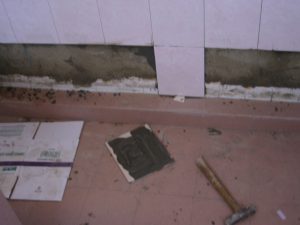

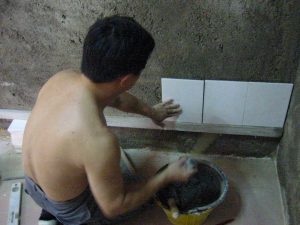
Types (BS 5980:1980)
Type 1
Hydraulically hardening mortar, which consists of a mixture of a hydraulic binding agent, usually Portland cement, mineral aggregates and organic additives, produced as a dry mixture, to be mixed with water before use.
Type 2
Dispersion adhesive, which is manufactured as a ready mixed-use mixture and consists of organic binding agent(s) as an aqueous emulsion or latex with mineral filling material.
Type 3
Dispersion/ cement adhesive, which consists of either Portland cement complying with the requirements of BS 12, or other prepared powder component, mixed into an aqueous dispersion of a polymeric material a short time before use.
Type 4
Dissolved resin adhesive, which is manufactured as a factory- prepared ready-for-use mixture and consists of fillers dispersed in a solution of an organic binding agent in volatile solvent.
Type 5
Reaction resin adhesive, which consists of two or more separately supplied components, each of which may contain mineral filler(s), and which have to be mixed together in specified proportions immediately before use
Classification (BS 5980:1980)
- Class AA: materials with a faster development of water resistance
- Class A: materials with slower development of water resistance
- Class B: materials with no requirement of water resistance
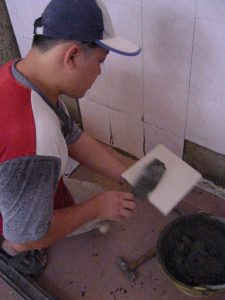
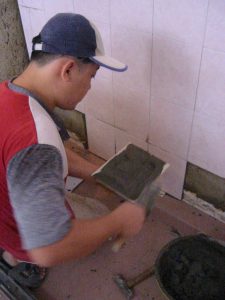
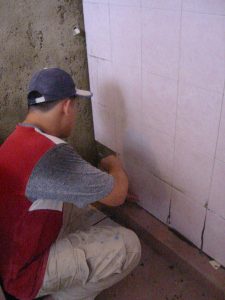
Specification (EN 12004: 2001)
- Cementitious adhesive: mixture of hydraulic binding agents, aggregates, and organic additives. The additives are mixed with water or liquid admix just before use.
- Dispersion adhesive: mixture of organic binding agent(s) in the form of an aqueous polymer dispersion, organic additives, and mineral fillers. Mixture is ready for use.
- Reaction resin adhesive: mixture of synthetic resin, mineral filler(s) and organic additives in which hardening occurs by chemical reaction. They are available in one or more component forms.
Adhesion Strength
Maximum strength per unit surface area, which can be measured by shear or tensile testing. Testing method is according to:
- EN 1348: 1997 for cementitious adhesive (shall be >= 0.5 MPa and >= 1 MPa for special characteristics).
- EN 1324:1996 for dispersion adhesive (shall be >= 1MPa).
- EN 12003:1997 for reaction resin adhesive (shall be = 2MPa).
| Class AA, A and B | >= 950 N after 14 days under normal condition |
| Class AA only | >= 560 N after 7 days under normal condition and followed by 7 days immersion in water at laboratory temperature |
| Class A only | >= 560 N after 14 days under normal condition and followed by 7 days immersion in water at laboratory temperature |
Tensile adhesion test according to BS 5980:1980
| Class AA, A and B | >= 4.5 kN after 7 days under normal condition followed by 7 days storage in an oven at a temperature of 100 ±2 ºC |
| Class AA only | >= 4.5 kN after 7 days under normal condition and followed by 7 days immersion in water at laboratory temperature |
| Class A only | >= 54.5 kN after 14 days under normal condition and followed by 7 days immersion in water at laboratory temperature |
Shear adhesion test according to BS 5980:1980
Open Time
Tested to BS 5980:1980, defined as the interval after which the tensile adhesion strength drops below 950 N, shall not be less than that stated by the manufacturer.
Substrate [4]
| Background Material | Cementitious adhesive (with liquid latex) | Epoxy based adhesive | ||
| Interior | Exterior | Interior | Exterior | |
| Concrete | S | S | S | S |
| Masonry | S | S | S | S |
| Cementitious backer board/ plaster | S | S | S | S |
| Existing ceramic, stone, terrazzo | S | S | S | S |
| Gypsum board/ plaster | S | C | S | S |
| Exterior grade plywood | U | U | S | S |
| Vinyl, Plastics, Laminates | U | U | S | S |
| Steel | U | U | S | S |
| S= Suitable; U= Unsuitable;
C= Different types. Consult supplier for the applicability. |
||||
Thickness
- 2-6mm [1]
- 2mm is enough for small mosaic tiles, whilst 6mm for large stone slabs.